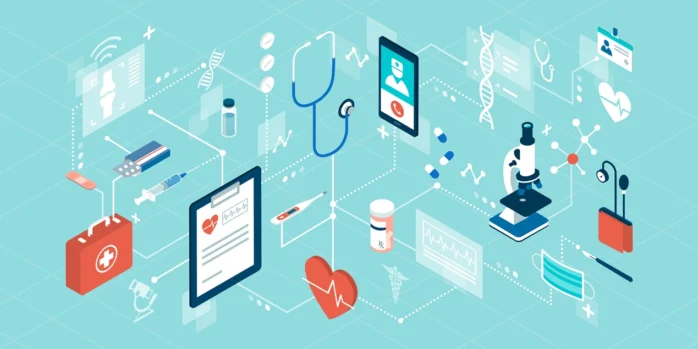With the rise of technology, the healthcare industry has seen significant advancements in recent years. One such advancement is telemedicine, a term used to describe the practice of providing medical care remotely, using telecommunications technology.
This innovative approach to healthcare has revolutionized the way doctors and patients interact, enabling them to connect in real-time without the need for physical proximity.
Telemedicine has become increasingly popular over the years, and its benefits are clear to see. In this article, we will explore the various aspects of telemedicine and how it is shaping the future of healthcare.
What is Telemedicine?

Telemedicine is the use of technology to deliver medical care remotely, from a distance. This can be done using videoconferencing, phone calls, or messaging services, depending on the situation. Telemedicine can be used to provide consultations, medical diagnosis, and even treatment, making it a versatile tool in the healthcare industry.
The concept of telemedicine is not new, as it has been in use for decades in the form of telephonic consultations, but the recent advancements in technology have made it more accessible and cost-effective.
How Telemedicine Works?
Telemedicine works by allowing doctors and patients to communicate remotely, using various digital platforms. This can be done through video conferencing, messaging services, or phone calls, depending on the type of consultation required.
For example, if a patient needs a quick consultation, a messaging service may be sufficient, while a video conference would be needed for more complex diagnoses or treatment.
Benefits of Telemedicine

The benefits of telemedicine are numerous, and they are not limited to patients alone. Here are some of the key benefits of telemedicine:
- Accessibility: Telemedicine provides patients with greater accessibility to healthcare services. With telemedicine, patients no longer need to travel long distances to see a doctor, making it easier for them to get the care they need, regardless of their location.
- Convenience: Telemedicine is also very convenient. Patients can connect with their doctors remotely, from the comfort of their homes, saving them time and money.
- Cost-Effective: Telemedicine can be more cost-effective than traditional healthcare, as it eliminates the need for physical facilities and reduces administrative costs.
- Improved Patient Outcomes: Telemedicine has been shown to improve patient outcomes, as patients are more likely to follow through with their treatment plans and take their medications as prescribed.
- Better Patient Engagement: Telemedicine also improves patient engagement, as it allows patients to be more involved in their care. This can lead to better treatment outcomes and improved patient satisfaction.
Applications of Telemedicine

Telemedicine can be used in various settings, including hospitals, clinics, and homes. Some of the common applications of telemedicine include:
- Teleconsultations: Teleconsultations are used to provide medical advice and consultations remotely. This is especially useful for patients in remote areas who do not have access to healthcare facilities.
- Telemonitoring: Telemonitoring is used to remotely monitor patients’ health conditions, allowing doctors to track their progress and adjust treatment plans as needed.
- Telestroke Care: Telestroke care is used to diagnose and treat stroke patients remotely, enabling doctors to provide timely care and prevent long-term disabilities.
- Telemental Health: Telemental health is used to provide mental health services remotely, allowing patients to access care from the comfort of their homes.
While telemedicine has several challenges that must be addressed in order to ensure its continued success.
One of the biggest challenges of telemedicine is the issue of access. While telemedicine can be a great way to increase access to healthcare services for people who live in remote or underserved areas, not everyone has access to the necessary technology.
Many people lack reliable internet access, which can make it difficult or impossible to access telemedicine services. Additionally, not everyone has the skills or knowledge necessary to use telemedicine platforms effectively, which can limit their ability to take advantage of these services.

Another challenge of telemedicine is the issue of reimbursement. Many insurance companies and government programs have been slow to adopt telemedicine as a covered service, which can make it difficult for healthcare providers to offer these services. Additionally, the reimbursement rates for telemedicine services are often lower than those for in-person care, which can make it less financially feasible for healthcare providers to offer these services.
Finally, privacy and security concerns are also a challenge for telemedicine. The transmission of sensitive medical information over the internet can pose a risk of data breaches and cyberattacks, which can compromise patient privacy and confidentiality. Healthcare providers must take steps to ensure the security of their telemedicine platforms and protect their patients’ information.
The telemedicine market has experienced significant growth in recent years, and this trend is expected to continue in the coming years. According to Persistence Market Research, the Global Telemedicine Market is anticipated to have a staggering CAGR of 17.2% by 2028. One of the major factors driving the growth of the telemedicine market is the increasing demand for remote healthcare services.
Telemedicine has proved to be a valuable tool in providing remote care to patients who are unable to visit healthcare facilities in person. The COVID-19 pandemic has also played a significant role in accelerating the adoption of telemedicine, as it has become a critical tool for providing safe and efficient healthcare services during the pandemic.

In addition, the increasing prevalence of chronic diseases such as diabetes, heart disease, and cancer is also driving the demand for telemedicine services. Telemedicine offers a convenient and cost-effective way to monitor and manage chronic conditions, which can help to improve patient outcomes and reduce healthcare costs.
Overall, the telemedicine market is expected to continue to grow as healthcare providers and patients increasingly recognize the value of remote healthcare services. As technology continues to advance, telemedicine is likely to become an even more integral part of the healthcare system, helping to improve access to care and patient outcomes.



















